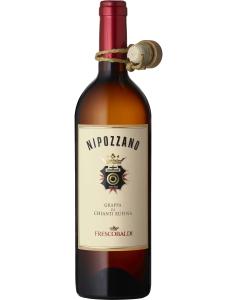Grappa is the classic Italian grape spirit, produced primarily in northern Italy from such regions as Veneto, Tuscany and Piedmont. The vineyards of Tuscany produce it in both quality and quantity.
Tuscan grappas (the Italian plural is grappe) are made not only as a by-product of the region's vast Chianti production, but also from grapes grown on such hallowed turf as Montalcino. Grappas distilled there are typically named Grappa di Brunello to reflect this prestige, and are made from Sangiovese grape residue left over from Brunello wine production. Held in similarly high regard is Piedmont's Grappa di Barolo, distilled from Nebbiolo wines from the famous village of Barolo.
Grappa is a pomace brandy which, like much French eau-de-vie, is made from distilled grape marc (pomace). Pomace is the residual grape skins and seeds left behind after pressing, and is discarded or used as fertilizer if not being used to make grappa. The spirit is normally released at an alcoholic strength of between 35% and 55% alcohol by volume, making it one of the world's stronger alcoholic drinks.
Several sub-categories of grappa have been identified to help distinguish between the various styles available. These are: giovane (pure and unaged), invecchiata (aged for 12 months or more), riserva invecchiata or stravecchia (aged for 18 months or more), aromatica (made from aromatic grapes) and aromatizzata (aromatized). Perfumed grappa aromatizzata is distilled with fruits, herbs or roots and has a quite different organoleptic profile from the standard spirits. Quinine, the bark of the Chinchona tree, is sometimes used as the aromatic agent, particularly in Barolo. It is known as china (pronounced kee-nah) in Italian, and beverages are identified by the adjective chinato (keen-'ato), as in Barolo Chinato.
The name of grappa is now protected and regulated under European Union law in an attempt to prevent its misuse either by Italian producers using the name for low-quality spirits or by non-Italian distillers trading on the name's Italian cachet. To be legally labeled 'grappa', a spirit must have been distilled in Italy, from grape pomace and without the addition of water. If whole grape must is used to make the spirit, it is termed acquavita d’uva and is comparable to French eau-de-vie de vin (e.g. Eau-de-vie de vin de Bourgogne).
A further law created to protect grappa and its consumers regulates who can and cannot produce grappa. It also outlines how the drink should be made; a dangerous by-product of the grappa distillation process is methyl alcohol (methanol), which must be carefully separated from the ethyl alcohol (ethanol) before the drink is safe for consumption. Winemakers must acquire a license if they intend to produce grappa from their marc. Alternatively, they can sell their grape marc to licensed grappa producers, or have it distilled under contract. The aim is to prevent clandestine 'moonshine' distillation. Although no law is ever entirely enforceable, illegal grappa production is reportedly rare in Italy.
Because only dry skins and pips are used to make grappa, the resulting product has less of a fruity character than a spirit distilled from wine. Thus the spirit's qualities are demonstrated more through its mouthfeel than flavor or aroma, placing further onus on the quality of the base product and the distillation techniques.
Grappa's place in Italian culture is as a digestivo, a digestion aid after the long, hearty meals for which Italy is famous. It is taken either on its own or as the ‘correction’ to coffee in a caffè corretto. In Veneto, where a significant proportion of Italy’s grappa is made, the spirit is used to rinse the final drops of liquid out of an espresso cup. Contrary to common belief, the Veneto town of Bassano del Grappa is not where grappa was first made. The town was founded by a Roman named Bassianus, which explains the first half of the name. It took the suffix of del Grappa to honor the dead of the terrible World War II battles that took place on Monte Grappa, the 5825ft (1775m) mountain rising immediately north of the town. The name grappa is more likely to have evolved into its present form over many centuries.
Unlike Cognac, Armagnac and Calvados, grappa is not typically aged in barrels (this gives the other three their rich color) and is therefore a clear spirit. Aged grappas are becoming more common in the early 21st Century, however. Two notable examples of aged grappa are produced by Jacopo Poli: one is aged in barrels previously used to age the famous Super Tuscan wine Sassicaia, and the other is aged for a full 13 years in oak.
As Italy seeks to raise the quality and reputation of its wines in an increasingly competitive global market, there is a role for grappa to play. If the nation can capture the world's attention with high-quality grappa, there will be a natural knock-on effect for the wines that lie behind them. Moscato, Cognac and Champagne have all risen to cult status in the United States of late; grappa may well follow in their footsteps.


